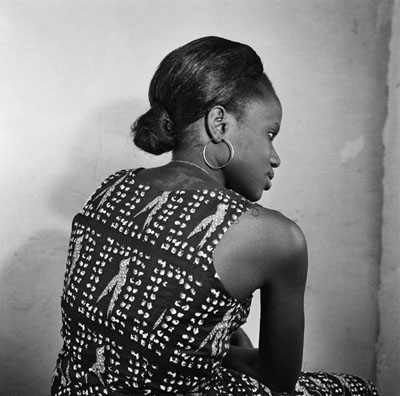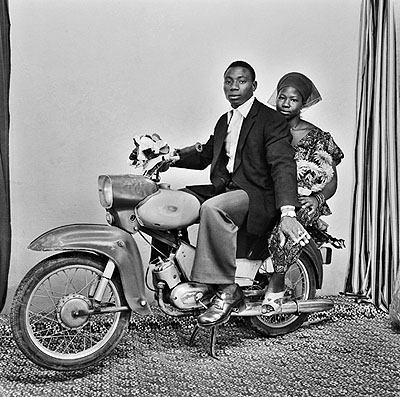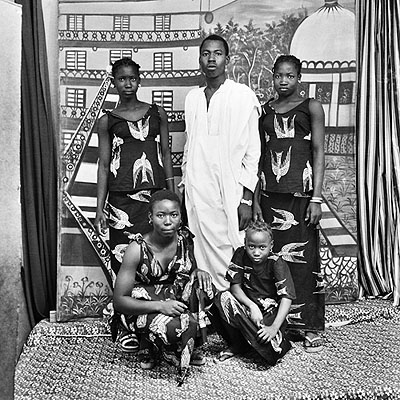
Malick Sidibé »
La vie en rose
Curated by Laura Serani and Laura Incardona
Exhibition: 9 May – 31 Jul 2010
Collezione Maramotti
Via F.lli Cervi 66
42124 Reggio Emilia
+39 0522-382484
info@collezionemaramotti.org
www.collezionemaramotti.org
Thu, Fri 14:30-18:30 . Sat, Sun 10:30-18:30

Malick Sidibé La vie en rose Curated by Laura Serani and Laura Incardona Inauguration by invitation only Saturday 8 May h 6.00 pm, the author will be present. The exhibition, with free admission, may be visited from 9 May to 31 July 2010 during the opening hours of the permanent collection. Sunday 9 May 2010 the photographer will attend the exhibition where he will meet visitors and take photographs of participants in the following hours: from 10 am to 12.30 and from 3.00 to 6.00 pm. Collezione Maramotti is pleased to present Malick Sidibé. La vie en rose, Italy's largest solo exhibition dedicated to the photographer. The exhibition develops within the framework of the event Fotografia europea, organized by the town government, and this year in its fifth edition, dedicated to the theme of Enchantment as the meaning and direction of a fascinated, enchanted, surprised and positive, forward-projected look, capable of seeing with new eyes what is before us, and questioning the signs of transformation and change. The exhibition presents a selection of circa 50 - mostly unpublished - photographs taken in Mali's capital Bamako, in the 1960s-1970s period. Photographies fully unveiling the magic and excitement of life in Bamako in those years, when the desire to be together, of being part of history in its making seemed imperative; images which have made Sidibé world famous: the parties in the 1960's, studio portraits and a selection of photographs from his archives, which tell us a long stretch of time in the history of Mali. «I believe in the power of image and this is why I lived all my life making portraits of people in the best possible way, trying to give back to them as much beauty as I could, because life is a gift from God, and should be better lived with a smile on your face. Too often is Africa's image linked to pain, poverty, misery, but Africa is not only that, and this is what I have always wanted to depict in my images»: these are Malick Sidibé's words about his activity as photographer and the value of his photography within the framework of the personal and social history of his country. «I have always had a talent for observation. I like to watch people, trying to understand them, to make a contact with them», he says. «I am a true witness of the changes in my Country, because photography does not tell lies, at least black and white photography, which I have always done. This is why I strongly believe that my photography is much more truthful, real and direct than any word. It is simple, anyone can understand it, and it tells an epoch, without deception. Humanity has always searched for immortality in painting or poetry, in writing, but in the past only kings and the wealthy could have their portrait made. Photography is a way to live longer, even after your death…» The reconstruction of Studio Malick and the photographer's presence in the two opening days of the exhibition will enable visitors to see the author at work while taking photographs of participants and chat with him. For the exhibition the first Italian monograph dedicated to the author will be published by Silvana Editoriale. The book in three languages, edited by Laura Serani and Laura Incardona, presents around one hundred images, together with the contribution by the curators of the exhibition. Malick Sidibé was born in 1936 in Soloba, a village 300 kilometres away from Bamako. In 1955 he graduated in drawing and jewellery-making at the Sudanese School of crafts, where he was the first of his course. Young Sidibé became fascinated with photography and decided to stay with Guillat-Guignard as his apprentice, after having received the assignment to decorate the French photographer's shop. In 1957 he started making his first reportages of parties, christenings and weddings. In 1960 he started his career as a free-lancer and in 1962 he opened the Studio Malick, in the popular neighbourhood of Bagadadji, where he continued his activity as portraitist. At the same time Sidibé depicted the nights of Bamako and the holiday afternoons spent on the banks of the Niger river: Mali had won its independence just two years before and the Country was full of new energy and enthusiasm. News and information went around, films arrived from Europe, India and the United States, but it was mostly music that brought fast and widespread changes with it in Bamako society. The photographer attended the parties of young people wearing Western clothes and dancing to the music of record players: his photographs depicted joyful youths, full of zest for life and hopes for their future. Night clubs with exotic names were opening everywhere in town and Sidibé was invited to all big events: his fame was so great that if he could not participate, then they would change the time or even the day of the event. In the late 1970's, Sidibé decided to focus his activity on studio portraits. After having exchanged a few words with the people to make them feel at ease, Sidibé himself would choose their pose for the sitting, succeeding in grasping the essence of their personality in just a few snaps. In 1994, during the first edition of Rencontres de la Photographie de Bamako, his portraits were exhibited for the first time together with Seydou Keïta's works (another great author from Bamako who was about ten years his senior and died in 2001). Western authors and critics discovered their talent. Soon after that Sidibé's photographs went to Paris, at first at Fnac Etoile and later at the Fondation Cartier pour l’art contemporaine; in just a short while museums and galleries from all over the world started exhibiting his works. The author still lives and works in Bamako. Today Sidibé is considered Africa's most important living photographer. In 2007 the Venice Biennale honoured him with the Golden Lion for the career, awarded for the first time to a photographer. In 2003 he won the Hasselblad Prize in Sweden, in 2008 the ICP Award in New York, in 2009 the prize PhotoEspaña-Baume & Mercier in Madrid, and this year the World Press Photo for the Arts and Entertainment Section in Amsterdam. Many publications and books on his work have been printed in Europe, the United States and Africa.

